Policy Updates and Connections in Northern Michigan
Posted by Lake Superior Community Partnership on January 24, 2022
In economic development, connections count. 
LSCP’s ability to connect businesses and the region with decision-makers across Michigan is a case in point. By building relationships with legislators, state agencies, and other influential organizations, we can act as a strong voice for the priorities we hear about from our members and the region.
One of our many paths to act as that voice is our partnership with the Northern Michigan Chamber Alliance (NMCA). Last week, the NMCA held its annual policy conference in Traverse City, featuring presentations from Governor Whitmer, Senator Peters, Representative Bergman, state representatives and senators, MSHDA and MEDC leaders, the Home Builders’ Association of Michigan, and Business Leaders of Michigan. Speakers provided an overview of some of the biggest economic issues facing northern lower Michigan and the U.P., along with insight on how decision-makers are addressing some of those issues:
- Talent: Business Leaders of Michigan’s presentation stressed the importance of attracting working-age Michiganders: to compete economically, the state needs 260,000 new working-age residents by 2030. How do we get them? Recommendations focused on increasing efforts around attraction, retention, and immigration; removing barriers to work; retraining and upskilling lower-wage workers; and above all, investing in K-12 and secondary education.
- Broadband: High-speed Internet is an “essential service” needed for economic development and to capitalize on opportunities for remote workers. Michigan’s new Office of High-Speed Internet puts a focus on expanding broadband access across the state and identifying those areas of greatest need – like large sections of the U.P.
- Childcare: The NMCA advocated heavily for childcare programs in 2021, and the Policy Conference – coming on the heels of the Governor’s announcement of $1,000 bonus payments to childcare workers – emphasized the importance of childcare initiatives in keeping people at work and bringing them back.
- Housing: Housing was a major focus, including discussion on legislation known as the “Housing Michigan bills,” which would provide more ways for local governments to incentivize housing development. Meanwhile, a number of proposals would use surplus state dollars to boost funding for housing through new and existing programs.
- Office of Rural Development: A long-time policy priority for the U.P., the Office of Rural Development was established by the Governor early this month, with legislation from Senator McBroom proposed to “institutionalize” the office. This offers an important opportunity to coordinate state agencies and programs in the context of rural needs, to determine how Michigan programs and policies might work better for rural communities, and to provide support for communities to help them access funding.
- Budget Surplus: As the Policy Conference was underway, news came out that the state’s revenue forecasts were even higher than anticipated. With over $20 billion in extra revenue to spend in Michigan, decision-makers are considering proposals from all angles, on all topics, about how to spend the dollars, and how to balance timing and priorities. One idea discussed at the conference was a regional approach to allocating money, with speakers pointing to the example of Indiana, which provided $500 million grants to regions for economic acceleration – funding that is anticipated to leverage private investment at a 10:1 ratio. A regional approach to funding could be transformative for the U.P., providing the flexibility and resources needed to address our unique challenges.
What’s next for these issues? Policy and budgets are still being shaped, which gives us a window for influencing those decisions. We all need to continue to share our priorities with our legislators, and the LSCP is here to help lift those priorities – so stay connected with the LSCP to amplify your voice on the region’s economy!
Sarah Lucas, CEO, writes a bi-weekly column for the Mining Journal.

